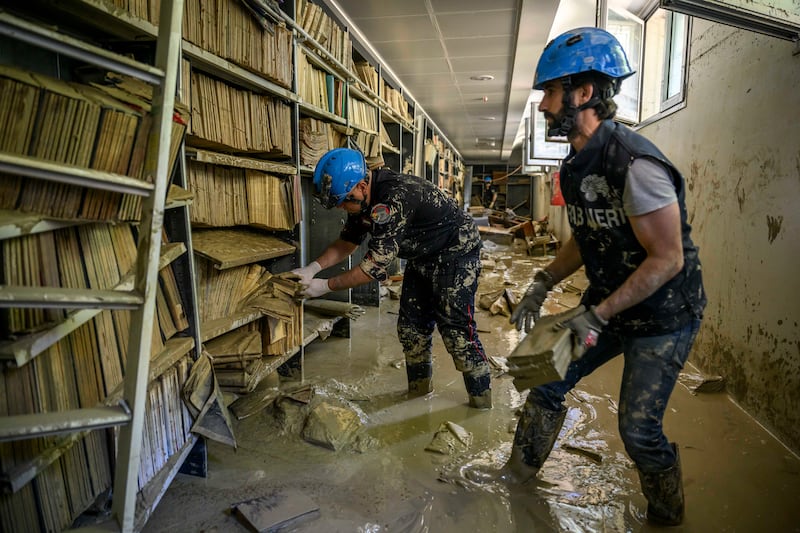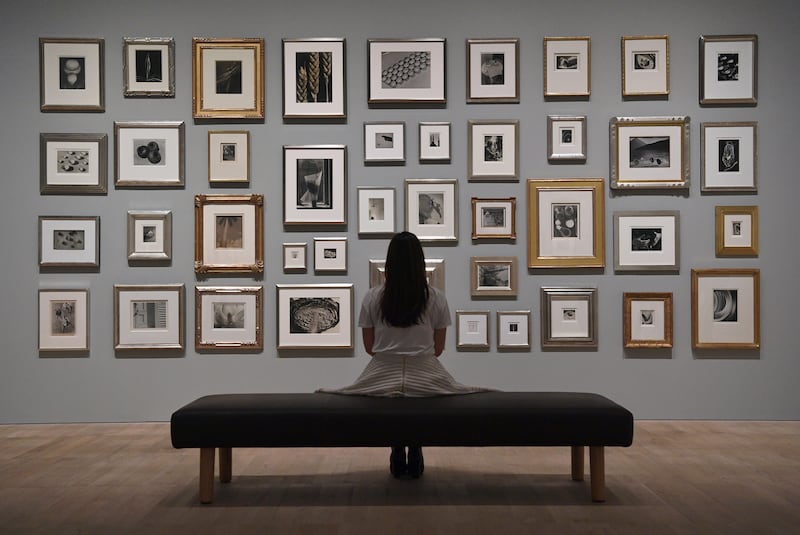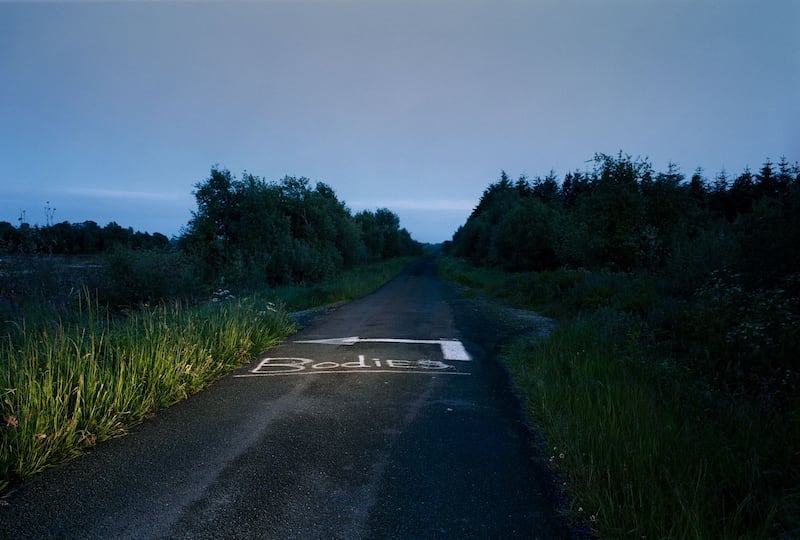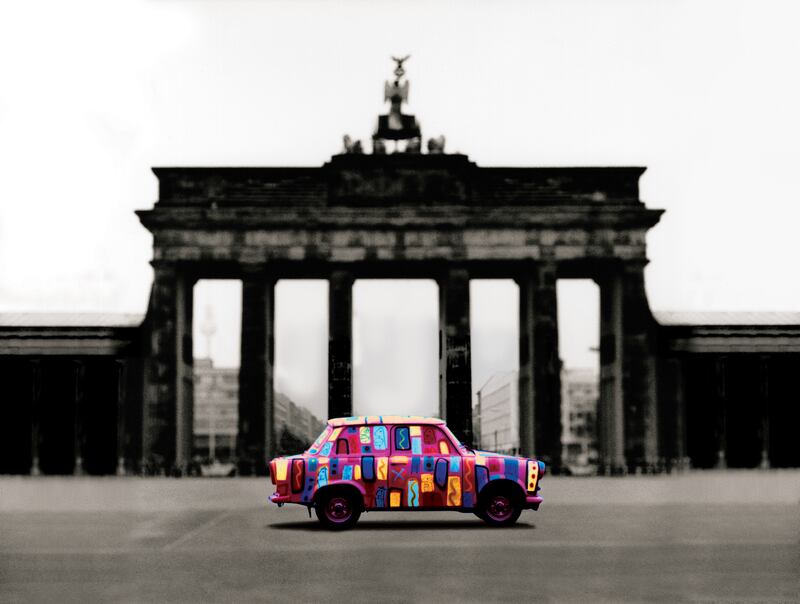In May this year, after months of drought, heavy rains hit the Italian region of Emilia-Romagna. They came in waves, killing more than 15 people and displacing tens of thousands. On May 14th the rising waters severely damaged the home of the Irish photographer David Farrell and his Italian wife, the artist Gogo della Luna, and wiped out his artistic archive.
“It was a very strange feeling,” Farrell says. The expected storms hadn’t come, but a general flood warning had been issued. He had begun moving some things upstairs, and had found a suitable board to create a barrier at the front door. “The water started slowly to rise and rise, like a horror movie. The board was holding, but then it started to come through the front wall of the house.” He breaks off, visibly upset. Beside him, della Luna gets up and leaves the room, unable to bear to hear the repeating of this recent history.
Farrell tells of the force of water from overwhelmed drains, of pushing heavy concrete blocks up, and of the aftermath, trying to rescue negatives, peeling sodden papers apart, seeing images from series such as his award-winning Innocent Landscapes project, made at the burial places of the IRA Disappeared, disintegrate.

It is a conversational cliche to ask someone what they would save from a burning building or salvage from a sinking boat, but when the unthinkable happens the mind instead goes back to range over all the things you could have done to safeguard what is most precious.
RM Block
Farrell had actually been working on finding a safe home for his work. “Ironically, recently I was more concerned about the vulnerability of my digital archive.” He had been cataloguing and collating computer hard drives. But, Farrell continues, “one of the aspects that deepens the shock of this event is a year-long feeling of the work I have made slipping into a Stygian obscurity”.
That nagging anxiety had led him to approach the National Gallery of Ireland in August 2022 to try to open a dialogue about it taking on his archive. In March this year he received a reply that stated regret at the delay and told him the gallery had decided not to pursue the idea but would keep Farrell’s material on file and perhaps “revisit the possibility of acquiring some prints”.
There is a general misunderstanding of what it takes to safeguard fine-art photography. After all, we live in an age of an abundance of imagery. Take a look at Farrell’s website and you’ll see images of the work that is lost – so how come it’s lost? What does that even mean? As Farrell outlines, the individual images that might make it to exhibition are either a selection from or a culmination of a much wider body of work. There are notebooks, negatives, thoughts and many, many images that might, later, become differently significant, and those are what a true archive protects. A great deal of valuable work exists behind the artworks we may come to know at exhibition.

Equally, museum-quality prints themselves are of such a high resolution that the kind of compressed JPEG file you might find online, or even on Instagram, will never print truly and crisply at scale. “Ireland has yet to have its Cruel and Tender moment with regard to photography,” Farrell says, citing a seminal exhibition at Tate Modern in London in 2003, which kick-started that institution’s collecting of the medium in depth. At the Irish Museum of Modern Art, the photography collection is disproportionately reliant on the generosity of David Kronn, who gifted his collection, including some of Farrell’s work, to the museum. Overall, Farrell describes a “cultural laziness and a failure to support native practitioners of the medium”.
Sifting through the wreckage of his personal collection and work, he immediately discarded some material, if only to create the physical space necessary to save other work. “I knew as soon as I began that I was bearing witness as part of a process of saying goodbye to some very precious negatives and prints in particular,” he says. “The notion of home and studio being flooded ... [means that] there is no respite from the impact of the water. I am still bereft for the work.” He describes that sense of bereavement eloquently, like an unwinding of time. Waterlogged images bringing him from Paris to Dublin, London or Rome to primary school, “memory dissolving as I attempt to salvage them”.
Alongside this, he is grateful to the team at Photo Museum Ireland, and at the Library Project, who have done their best to rally support, but what should artists do to protect their own work, either from natural disaster or from the depredations of time? It is a question that will come to trouble all artists at a certain point in their creative careers. At the recent Borris House Festival of Writing & Ideas, the artist and writer Edmund de Waal spoke eloquently about memory and loss in conversation with the artist Dorothy Cross, describing a sense of “goneness”, of things not surviving, a process that reflects the brokenness of life and of history. Still, he concluded, even that sense needs holding and preserving in some way.

Trish Lambe of Photo Museum Ireland talks about the difference between a museum collection, which safeguards individual works, and archives, which create and take care of a record of a whole artistic practice. All artists, in whichever creative medium they work, can benefit from her advice. “It is never too early to start,” she says, reminding students and early-career artists to keep a record of their work, including sketchbooks, and, crucially, to keep a register of sales and gifts of work, before memories and locations get lost through time.
That, however, takes not only time but also space. Making museum-quality digital scans takes hours, and physical storage requires protective materials and climate-controlled conditions. Even the most amenable museum in the world wouldn’t be able to accept every donation or archival-partnership request. Photo Museum Ireland works with both the National Gallery and the National Photographic Archive, benefiting from and sharing expertise. Lambe also cites Nival, the National Irish Visual Arts Library, at NCAD for its work in cataloguing, storing and digitising catalogues and exhibition ephemera, including invitations from over the years.
Brendan Maher recently joined Photo Museum Ireland to manage its digital arts and archive collection. He formerly worked at the National Gallery and as photography-asset manager for U2; he was responsible for the day-to-day management and archiving of the band’s photography collection, which includes work by Anton Corbijn. He is organising a series of free archiving workshops, launching in August as part of Heritage Week.
[ From the Stones to U2 - how Anton Corbijn captured the soul of rock’n’rollOpens in new window ]

According to both Maher and Lambe, more funding is needed to support the development and care of archives, although they both praise the Heritage Council’s museum-standards programme, which has led to a general increase in standards in museum and gallery archiving and collections care.
“The early street photography and Innocent Landscape negative losses were hard to absorb,” Farrell says, describing how the flood hit him and della Luna in different ways. “The violation of the house as an oasis had hit her so hard; I foolishly and romantically hoped that if I could save the deep past it might soften the present for her, but more and more know this to be futile.” As the couple try to put things back the way they were, the artistic loss grows even greater in comparison. In an age when we believe that everything is saved and stored online somewhere, it’s important to remember that this isn’t precisely true. Deliberately archiving and protecting work won’t protect you from a flood, but it could well be the saving of a legacy.
How to create and keep an archive
According to Brendan Maher of Photo Museum Ireland, who is working alongside his colleague Trish Lambe on a guide for artists that will be on the museum’s website, there is plenty people can do, even without top-of-the-range equipment.
- Keep your work safe before it can be digitised.
- Store materials in archival-standard packaging. These are made of acid-free card and paper, and are widely available.
- For photographic work, separate negatives from prints, and pack each separately, to avoid compression damage.
- Package things carefully and don’t overload boxes and files.
- Don’t mix photographic materials, as a process known as “chemical off-gassing” can cause significant damage.
- Store materials off the floor in a stable, cool, low-moisture environment.
- Keep all materials off the floor on shelves, even when packaged.
- Avoid storing photographic materials near any water or heat source.
- Back up digital files. Have a physical as well as cloud storage of all digital files.
- Re-store digital files as operating systems or storage devices become obsolete.
- Scan and archive to the highest resolution you can achieve.
- Label everything, including title, location, date and year.
- Never assume you’ll remember details. Note them down with each image, notebook or storage drive.
For information about securing a place at one of Brendan Maher’s archiving workshops, email brendan@photomuseumireland.ie























